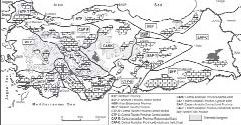Review of Turkish Karst with Emphasis on Tectonic and Paleogeographic Controls
DOI:
https://doi.org/10.3986/ac.v32i2.349Povzetek
This paper re-evaluates the karst phenomenon in Turkey basing on the controlling factors such as, the source of energy gradient, lithostratigraphy, type of erosion base and climate. Two major karst types described are a) evolutionary karst which implies continuous karstification but at different stage of maturation and b)rejuvenated karst which is formed by reactivating a formerly developed and subsequently ceased karst structure either by an uplift and/or a drastic decline of erosion base. Description of karst types considering both morphology and hydrogeology revealed that distribution of specific karst types is compatible with the neotectonic evolution of Turkey. Karst in all provinces except the Black Sea and Western Anatolian regions, is developed under the effect of the energy gradient provided by uplift. Different rates of uplift created different sub-types of karst. The climate effect was evaluated as a secondary factor for it has a role of shaping/re-shaping the karst forms rather than controlling the physical and chemical processes.
Prenosi

Prenosi
Objavljeno
Kako citirati
Številka
Rubrike
Licenca
Avtorji jamčijo, da je delo njihova avtorska stvaritev, da v njem niso kršene avtorske pravice tretjih oseb ali kake druge pravice. V primeru zahtevkov tretjih oseb se avtorji zavezujejo, da bodo varovali interese založnika ter da bodo povrnili morebitno škodo.
Podrobneje v rubriki: Prispevki




